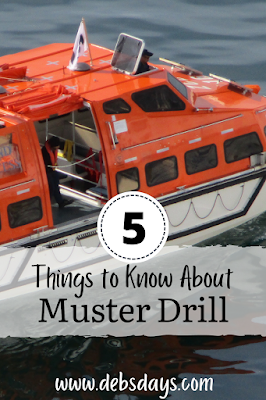Learn about five important things you need to know about the cruise ship's safety drill, called a muster drill.
The International Convention for the Safety of Life at Sea (SOLAS) requires all passengers attend a muster drill within 24 hours of sailing. Most ships hold these drills, where you learn about what to do in case of an emergency, before the ship leaves port. Like practicing a fire drill in school, a muster drill is a practice for an emergency. All passengers are required to attend. No matter how busy you think you are or how young your children are. No matter whether you are in a wheelchair or walk with a cane or dislike crowds. No matter how many times you’ve worn a life jacket in your life. No matter how many cruises you’ve been on before you must attend the muster drill.
2. If you try and skip it you will be caught.
Cabin stewards are responsible for checking each cabin. Don’t hide (or dawdle) in your cabin during the drill. When entering the muster station cruise cards are scanned by muster personnel. Scanning of cards by the electronic system assists crew in determining the attendance of passengers. So if you miss it, guess who will be found out and be required to attend a make up drill?
3. The siren to call you to the drill is loud.
An emergency broadcast alarm is sounded to call passengers to the muster stations for the drill and for a real emergency. It's a piercing alarm consists of seven short blasts followed by one long blast on the ship’s whistle. No matter where you are on the ship, you will most definitely hear it.
4. You may have to stand by your assigned lifeboat. Or you might not.
Each cruise line has its own way of gathering passengers for muster. Some cruise lines provide an area inside the ship away from the elements. Other cruise lines have passengers reporting to muster directly on deck near the assigned lifeboat. Be familiar with the muster drill procedure on your specific ship by reading details in the first day's paper and listening to the directions of ship personnel.
5. Elevators cannot be used during the muster drill or during a real emergency.
You will be directed down or up the stairs by stairway guides and muster personnel. If a disability prevents you from using the stairs, let them know. Better yet, go to your muster drill early when the elevators are still in service. If you know assistance will be needed in a real emergency let your cabin steward or the passenger services desk know so arrangements can be made. Special personnel are designated to assist passengers needing additional help.
It is in your best interest to take the muster drill seriously. What would you do if the captain came on the loudspeaker and told passengers there was a fire in the galley and ordered all muster crew personnel to the muster stations? Would you know to get back to your cabin and dress warmly and pack a small bag with your medications like we did? Would you then know where to go to evacuate the ship? Would you know how to put on your life vest? Every cruise we see people talking to others, texting, taking pictures, and even sleeping during muster. Don’t be one of them.

